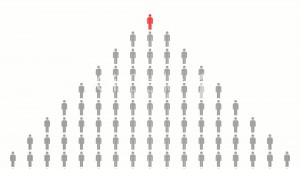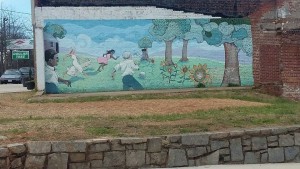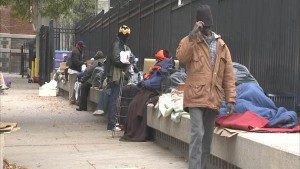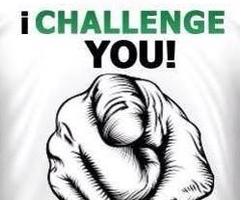Hierarchy of Space in Atlanta
Atlanta is a fast past city, filled with corporate and small businesses. The way the city of Atlanta is built defines itself and the people who live, work, and visit. The built environment has the ability to control an individual’s perception, such as, what type of people live in an area and what they are like. The built environment consists of any manmade structures with the purpose of human use. The built environment has the ability to influence what I like or dislike and even who I am as an individual. Most individuals do not understand the extent in which their built environment can influence every aspect of their lives. The built environment shapes who and what a person can become in the future. The built environment promotes a system of social hierarchy. In Atlanta and throughout the United States everyone is not treated equally. The built environment fosters the idea of inequality through architecture. The city of Atlanta, like other places, is defined by what consists inside of the area and who maintains it.
During the time I truly looked at environment (Atlanta), I noticed a social hierarchy based on the built environment or space in which different individuals live or are constantly around. I noticed how the built environment can define an individual. Depending on where a person lives, certain assumptions or judgements can be made about them before they speak or show any actions. People who live in the inner city, communities outside of the city, and the homeless have three distinct built environments. There are certain advantages and disadvantages in each environment.
While visiting the Oakhurst Community in Decatur, Georgia there was a high sense of community unlike in the city. There were parks and green spaces available. There were also nicely made homes that are pleasing to the eye, sidewalks, reminders to pick up after dogs, and a town center with restaurants. Seeing people taking an early morning run or walk with their dogs, gave me a sense of normality. There are Marta bus stops available in the neighborhood which allows more people access to the area. A mural in the neighborhood promotes diversity with a group of children of different races plating in a park. Without noticing, I had made preconceived notions about how the people in the neighborhood were based on the built environment they lived in.
The individuals were defined by their built environment (middle class Americans). There are certain advantages of living in a community outside of the city. The presence of green spaces allows residents a space to enjoy without the hassle of driving to find a green space. According to the Playing Field, “there is a clear correlation between regular use of good quality natural environments and improvement in health and wellbeing”. The residents of the Oakhurst Community have a greater chance of an active lifestyle because of their built environment. Green spaces are linked to better sleep, physical activity, and greater social interaction. The lack of noise and heavy traffic makes residence more likely to take a walk or go outside. The Oakhurst Community positively impacts the residents. On the flip side some individuals may not be able to afford to live in area that has properly built homes with a positive living environment. Some individuals are forced to live in the inner city.
The city of Atlanta is home to a very diverse group of individuals. The city has a plentiful amount of businesses, buildings, shopping areas, and is home to thousands of people. Individuals in the city of Atlanta have many different advantages and disadvantages because of the built environment. Atlanta is very fact past and because of the abundance of businesses there is media and promotions around every corner. People in the city are bombarded by the media they see and are often influenced to spend their money. The city of Atlanta is like a business marketing to people who have money. The built environment of cities is seen as a travel destination. Atlanta is a major workplace with many roads, highways, buildings, and skyscrapers. These building may intrigue outsiders to visit and increases revenue from travel. Those who have businesses in Atlanta have an economic opportunity because the abundance of people. Bike lanes allows an alternative option of travel in the city. Bike lanes expands traveling limits in the city. People who live in the city may be characterized as constantly busy or on the go. I have noticed that horns are honked more frequently in cities. Unlike in close knit communities, drivers are more easily frustrated with slow drivers in heavy traffic. Traffic is a major obstacle for people living in Atlanta. Certain individuals in Atlanta are deemed more important than others in this type of built environment.
The city of Atlanta has a high population of homeless individuals. The homeless that reside on the Georgia State campus are viewed as being on the bottom in a social hierarchy. The good environment of Atlanta does not have a place for the homeless. The homeless often reside in parks or areas that do not serve a purpose for many individual. The homeless individuals are judged based on their built environment. The homeless are seen as not having a home or place to go. Homeless individuals seem, to many people to be imposing on everything and everywhere they go, see, and touch even if the item is not in use. Sarah Schindler describes architectural exclusion in New York City. Architectural exclusion explains how the built environment purposely excludes certain individuals. Irina Nersessova illuminates readers’ minds by showing pictures of individuals who are classified as homeless but actually are not. The same exclusion, discrimination, and lack of respect is in Atlanta today as in New York City. While most homeless individuals do not have a stable home, they have spaces where they sleep and interact with other individuals. The homeless are not seen as people especially in a city with vast opportunity. People walking past a homeless individual may feel as though they are nothing like them. Most people will not and cannot relate to the homeless living outside on sidewalk and alleyways. The homeless individuals in Atlanta are treated as they are not human beings and are often overlooked.
The homeless are not the only group of overlooked individuals in the Built environment of Atlanta. Those with physical disabilities do not have equal access to certain places in Atlanta. While visiting the Municipal Market in Atlanta, I noticed how difficult it can be to navigate in a wheelchair. This disability inhibits customers from viewing menus high up and the ability to reach certain items or products. The interior and exterior built environment does not accommodate diversity of people very well. Some businesses and buildings do not have wheelchair access which prevents individuals from entering. Atlanta’s accessibility for everyone can improve to make the city better.
The internet and social media has a major impact on many individuals lives in Atlanta. The digital built environment also markets to certain groups and individuals. The way a website or app is made defines the site or product. The visual outlay of the digital environment is important in gaining or maintaining a buyer’s interest. The online built environment markets to certain individuals and maintains them by the content they provide. The way a website looks, how up to date it is, and its level of usefulness determines its popularity. Digital environments are designed in ways to keep interest in individuals. The digital environment is another way the built environment can shape and impact people. Those who do not use the internet are not equally represented as those who do. In Atlanta the use of technology is evident in everyday life. The lack of technological use can inhibit individuals from certain opportunities. @The built environment of Atlanta caters to certain individuals over others creating a social hierarchy. Opportunities for able bodied, independent, technologically inclined individuals with a stable home are endless. But for those who are homeless, disabled, and do not use technology, are not given the same opportunities as those who are not.
I challenge each individual not to judge a person based upon their built environment. A built environment can place limitations on a families and individuals, but it does not stop them from being a human being. The built environment can serve as an opportunity to some but a disadvantage. No one should be defined entirely by their built environment. Businesses can accommodate everyone instead of limiting an individual. Individuals do not have to place value over one individual over another. America is a land of opportunity despite living in Atlanta or any other place. Individuals in the hierarchy of Atlanta can break chains by fighting for more rights, voting for state officials, and most importantly by keeping an open mind. The built environment has a major impact on the lives of those who live in Atlanta but it does not have to define who we are. We can use the built environment to benefit all individuals instead of those at the top of the social hierarchy of Atlanta.
NERSESSOVA, IRINA. “Tapestry Of Space: Domestic Architecture And Underground Communities In Margaret Morton’s Photography Of A Forgotten New York.” Disclosure 23 (2014): 26. Advanced Placement Source. Web. 28 Apr. 2016.
SCHINDLER, SARAH. “Architectural Exclusion: Discrimination And Segregation Through Physical Design Of The Built Environment.” Yale Law Journal 124.6 (2015): 1934-2024. Academic Search Complete. Web. 28 Apr. 2016.
“I DARE YOU TO JOIN. LETS PARTY BLOGGING STYLE. – Librarians Are Humans Too.” Accessed April 28, 2016. https://theonettiencube32.wordpress.com/2015/04/24/i-dare-you-to-join-lets-party-blogging-style/.






